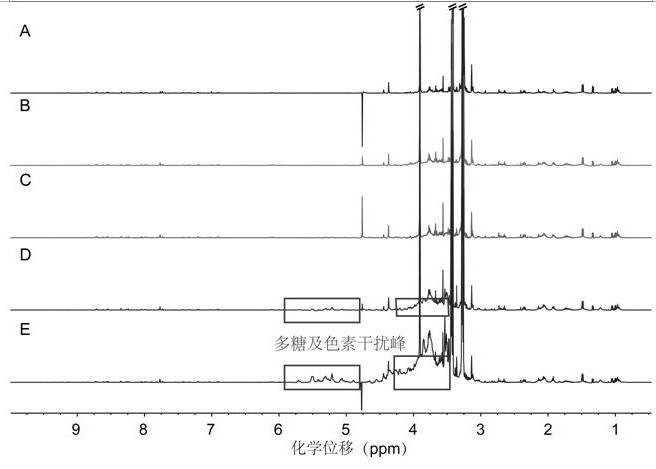A method for extracting abalone hepatopancreas metabolites
A technology of hepatopancreas and metabolites, which is applied in the field of molecular biology, can solve the problems that are not suitable for high-throughput, large-scale use, cannot effectively remove polysaccharides and pigments, and affect the quantification of important metabolites, so as to achieve the elimination of polysaccharides and pigments Interference, high recovery rate, low cost effect
- Summary
- Abstract
- Description
- Claims
- Application Information
AI Technical Summary
Problems solved by technology
Method used
Image
Examples
Embodiment 1
[0033] Example 1 Using the method of the present invention to extract abalone hepatopancreas metabolites
[0034] The specific method includes the following steps:
[0035] S1. Weigh 300 mg abalone hepatopancreas and place in a 5 mL centrifuge tube;
[0036] S2. Add 1.2 mL of methanol and 0.6 mL of water to the centrifuge tube in step S1, and add steel balls, and then place it in a low-temperature tissue grinder and vibrate at 4 °C to break;
[0037] S3. Add 1.2 mL of chloroform and 1.2 mL of water to the centrifuge tube in step S2, vortex at 2500 rpm for 1 min, and place it on ice for 10 min;
[0038] S4. Centrifuge at 10000 g for 10 min at 4 °C after standing still, and transfer the upper layer solution to another centrifuge tube;
[0039] S5. Put the upper layer solution obtained in step S4 into a freeze-dried powder by vacuum freeze-drying in a vacuum freeze dryer at -80°C after quick-freezing with liquid nitrogen;
[0040] S6. Add 0.9 mL methanol and 0.1 mL water (90% ...
Embodiment 2
[0047] Example 2 Using the method of the present invention to extract hepatopancreatic metabolites from abalone
[0048] The specific method includes the following steps:
[0049] S1. Weigh 300 mg abalone hepatopancreas and place in a 5 mL centrifuge tube;
[0050] S2. Add 1.2 mL of methanol and 0.6 mL of water to the centrifuge tube in step S1, and add steel balls, and then place it in a low-temperature tissue grinder and vibrate at 4 °C to break;
[0051] S3. Add 1.2 mL of chloroform and 1.2 mL of water to the centrifuge tube in step S2, vortex at 2500 rpm for 1 min, and place it on ice for 10 min;
[0052] S4. Centrifuge at 10000 g for 10 min at 4 °C after standing still, and transfer the upper layer solution to another centrifuge tube;
[0053] S5. Put the upper layer solution obtained in step S4 into a freeze-dried powder by vacuum freeze-drying in a vacuum freeze dryer at -80°C after quick-freezing with liquid nitrogen;
[0054] S6. Add 0.9 mL methanol and 0.16 mL wat...
Embodiment 3
[0061] Example 3 Using the method of the present invention to extract abalone hepatopancreas metabolites
[0062] The specific method includes the following steps:
[0063] S1. Weigh 300 mg abalone hepatopancreas and place in a 5 mL centrifuge tube;
[0064] S2. Add 1.2 mL of methanol and 0.6 mL of water to the centrifuge tube in step S1, and add steel balls, and then place it in a low-temperature tissue grinder and vibrate at 4 °C to break;
[0065] S3. Add 1.2 mL of chloroform and 1.2 mL of water to the centrifuge tube in step S2, vortex at 2500 rpm for 1 min, and place it on ice for 10 min;
[0066] S4. Centrifuge at 10000 g for 10 min at 4 °C after standing still, and transfer the upper layer solution to another centrifuge tube;
[0067] S5. Put the upper layer solution obtained in step S4 into a freeze-dried powder by vacuum freeze-drying in a vacuum freeze dryer at -80°C after quick-freezing with liquid nitrogen;
[0068] S6. Add 0.9 mL methanol and 0.23 mL water (80%...
PUM
 Login to View More
Login to View More Abstract
Description
Claims
Application Information
 Login to View More
Login to View More - R&D
- Intellectual Property
- Life Sciences
- Materials
- Tech Scout
- Unparalleled Data Quality
- Higher Quality Content
- 60% Fewer Hallucinations
Browse by: Latest US Patents, China's latest patents, Technical Efficacy Thesaurus, Application Domain, Technology Topic, Popular Technical Reports.
© 2025 PatSnap. All rights reserved.Legal|Privacy policy|Modern Slavery Act Transparency Statement|Sitemap|About US| Contact US: help@patsnap.com


